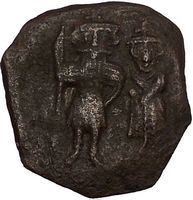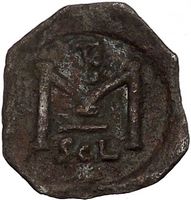Byzantine Empire
Constans II - Emperor: September 641-15 July 668 A.D.
withConstantine IV - Augustus from April 13, 654 A.D.
Bronze Follis 22mm (3.49 grams)Syracuse inSicily mint
Reference: Sear 1109; DOC 180
No legend. Constans (on left), with long beard, and Constantine IV (on right), beardless, standing facing, each wearing crown; Constans wears military attire, and holds long staff; his son wears chlamys and holds globe cross.
Large M; above, monogram 35; beneath, SCL. You are bidding on the exact item pictured, provided with a Certificate of Authenticity and Lifetime Guarantee of Authenticity. Constantine IV, (c. 652 – September 685), sometimes incorrectly called Pogonatos, "the Bearded", by confusion with his father;wasByzantine Emperor from 668 to 685. His reign saw the first serious check to nearly 50 years of uninterruptedIslamic expansion, while his calling of theSixth Ecumenical Council saw the end of themonothelitism controversy in theByzantine Empire. Early careerThe eldest son ofConstans II, Constantine IV had been named a co-emperor with his father in 654.He had been given the responsibility of managing the affairs atConstantinople during his father’s extended absence in Italy and became senior Emperor when Constans was assassinated in 668. His mother wasFausta, daughter of patricianValentinus.The first task before the new Emperor was the suppression of the military revolt inSicily underMezezius which had led to his fathers death.Within 7 months of his accession, Constantine IV had dealt with the insurgency with the support ofPope Vitalian.But this success was overshadowed by troubles in the east. As early as 668 theCaliphMuawiyah I, after receiving an invitation fromSaborios, the commander of the troops inArmenia to help him overthrow the Emperor at Constantinople, sent an army under his sonYazid against theEastern Roman Empire. Yazid reached as far asChalcedon and took the important Byzantine center Amorion. Although the city was quickly recovered, theArabs next attackedCarthage and Sicily in 669. In 670 the Arabs capturedCyzicus and set up a base from which to launch further attacks into the heart of the Empire. Their fleet capturedSmyrna and other coastal cities in 672. Finally, in 672, the Arabs sent a large fleet to attackConstantinople by sea. While Constantine was distracted by this, theSlavs unsuccessfully attackedThessalonika. The Siege of Constantinople: 674-678Then, commencing in 674, the Arabs launched the long awaited siege of Constantinople. The great fleet that had been assembled set sail under the command ofAbdul-Rahman ibn Abu Bakr before the end of the year; and during the winter months some of the ships anchored at Smyrna, the rest off the coast ofCilicia. Additional squadrons reinforced the forces of Abd ar-Rahman before they proceeded to theHellespont, into which they sailed in about April 674. From April to September 674 the fleet lay moored from the promontory of Hebdomon, on thePropontis, as far as the promontory ofKyklobion, near theGolden Gate, and throughout those months continued to engage with the Byzantine fleet which defended the harbour continued from morning to evening. Knowing that it was only a matter of time before Constantinople was under siege, Constantine had ensured that the city was well provisioned. He also constructed a large number of fireships and fast-sailing boats provided with tubes or siphons for squirting fire. This is the first known use ofGreek fire in combat, which was one of the key advantages that the Byzantines possessed. In September, the Arabs having failed in their attempts to take the city, sailed to Cyzicus, which they made their winter quarters. Over the following five years, the Arabs would return each spring to continue the siege of Constantinople, but with the same results. The city survived and finally in 678, the Arabs were forced to raise the siege. The Arabs withdrew, and were almost simultaneously defeated on land inLycia inAnatolia. This unexpected reverse forced Muawiyah I to seek a truce with Constantine. The terms of the concluded truce required the Arabs to evacuating those islands in the Aegean they had seized, as well as an annual tribute to the Emperor consisting of fifty slaves, fifty horses and 3,000 pounds of gold. The raising of the siege allowed Constantine to go to the relief of Thessalonika, still under siege from the Slavs. Later ReignWith the temporary passing of the Arab threat, Constantine had to turn his attention to the Church, torn betweenMonothelitism and Orthodoxy. In November 680 Constantine convened theSixth Ecumenical Council (also known as the Third Council of Constantinople). Constantine presided in person during the formal aspects of the proceedings (the first eleven sittings and then the eighteenth), surrounded by his court officials, but took no active role in the theological discussions. The Council reaffirmed the Orthodox doctrines of theCouncil of Chalcedon in 451. This solved the controversy overmonothelitism; conveniently for the Empire, most monothelites were now under the control of theUmayyadCaliphate. The council closed in September 681. Due to the ongoing concerns with the Arabs during the 670s, in the west, Constantine had been forced to conclude treaties with theLombards, who had capturedBrindisi andTaranto. As well, in 670 theBulgars underAsparukh crossed theDanube into nominally Imperial territory and began to subject the local communities and Slavic tribes. In 680, Constantine IV led a combined land and sea operation against the invaders and besieged their fortified camp inDobruja. Suffering from bad health, the Emperor had to leave the army, which allowed itself to panic andbe defeated by the Bulgars. In 681, Constantine was forced to acknowledge theBulgar state inMoesia and to pay protection money to avoid further inroads into ByzantineThrace. Consequently, Constantine created theTheme of Thrace. His brothersHeraclius andTiberius had been crowned with him as Augusti during the reign of their father, and this was confirmed by the demand of the populace, but in 681 Constantine had themmutilated so they would be ineligible to rule. At the same time he associated on the throne his own young sonJustinian II. Constantine died ofdysentery in September 685. FamilyBy his wifeAnastasia, Constantine IV had at least two sons: - Justinian II , who succeeded as emperor
- Heraclius
Constans II (Greek:Κώνστας Β, Kōnstas II), also called "Constantine the Bearded" (Kōnstantinos Pogonatos), (November 7, 630–September 15, 668) wasByzantine emperor from 641 to 668. He also was the last emperor to become consul in 642, becoming the lastRoman consul in history. Constans is a diminutive nickname given to the emperor, who had been baptized Herakleios and reigned officially as Constantine. The nickname established itself in Byzantine texts, and has become standard in modern historiography.// BiographyConstans was the son ofConstantine III andGregoria. Due to the rumours thatHeraklonas and Martina had poisoned Constantine III he was named co-emperor in 641. Later that same year his uncle was deposed and Constans II was left as sole emperor. Constans owed his throne to a popular reaction against his uncle and to the protection of the soldiers led by the general Valentinus. Although the precocious emperor addressed the senate with a speech blaming Heraklonas and Martina for eliminating his father, he reigned under a regency of senators led byPatriarch Paul II of Constantinople. In 644 Valentinus attempted to seize power for himself but failed. Under Constans, the Byzantines completely withdrew fromEgypt in 642, andCaliph Uthman launched numerous attacks on the islands of theMediterranean Sea andAegean Sea. A Byzantine fleet under the admiral Manuel occupiedAlexandria again in 645, but after a Muslim victory the following year this had to be abandoned. The situation was complicated by the violent opposition toMonothelitism by the clergy in the west, and the related rebellion of the Exarch of Carthage, Gregory. The latter fell in battle against the army of Caliph Uthman and the region remained a vassal state underCaliphate, until the civil war broke out and the imperial rule was again restored. Constans attempted to steer a middle line in the church dispute between Orthodoxy and Monothelitism, by refusing to persecute either and prohibiting further discussion of the natures ofJesusChrist by decree in 648. Naturally, this live-and-let-live compromise satisfied few passionate participants in the dispute. Meanwhile, theCaliphate advance continued unabated. In 647 they had entered intoArmenia andCappadocia, and sackedCaesarea Mazaca. In 648 the Arabs raided intoPhrygia and in 649 launched their first maritime expedition againstCrete. A major Arab offensive intoCilicia andIsauria in 650–651 forced the emperor to enter into negotiations withCaliph Uthmans governor of Syria,Muawiyah. The truce that followed allowed a short respite, and made it possible for Constans to hold on to the western portions of Armenia. In 654, however,Muawiyah renewed his raids by sea, and plunderedRhodes. Constans led a fleet to attack theMuslims at Phoinike (offLycia) in 655 at theBattle of the Masts, but he was defeated: 500 Byzantine ships were destroyed in the battle, and the emperor himself risked to be killed. Before the battle, chroniclerTheophanes the Confessor says, the emperor dreamt to be at Thessalonika, this dream predicted his defeat against the Arabs because the wordThessalonika is similar to the sentence "thes allo niken", that means "gave victory to another (the enemy)".[3] Caliph Uthman was preparing to attackConstantinople, but did not carry out the plan when civil war between the futureSunni andShia factions broke out among them in 656. With the eastern frontier under less pressure, in 658 Constans defeated the Slavs in the Balkans, temporarily reasserting some notion of Byzantine rule over them. In 659 he campaigned far to the east, taking advantage of a rebellion against the Caliphate in Media. The same year he concluded peace with the Arabs. Now Constans could turn to church matters once again.Pope Martin I had condemned both Monothelitism and Constans attempt to halt debates over it (theType of Constans) in theLateran Council of 649. Now the emperor ordered his Exarch ofRavenna to arrest the Pope. One Exarch excused himself from this task, but his successor carried it out in 653. The Pope was brought to Constantinople and condemned as a criminal, ultimately being exiled toCherson, where he died in 655. Constans grew increasingly fearful that his younger brother, Theodosius, could oust him from the throne: he therefore obliged him first to take holy orders, and later had Theodosius killed in 660. Constans sons Constantine, Heraclius, and Tiberius had been associated on the throne since the 650s. However, having attracted the hatred of citizens of Constantinople, Constans decided to leave the capital and to move toSyracuse in Sicily. From here, in 661, he launched an assault against theLombardDuchy of Benevento, which then occupied most ofSouthern Italy. Taking advantage of the fact that Lombard kingGrimoald I of Benevento was engaged against Frankish forces fromNeustria, Constans II disembarked atTaranto and besieged Lucera and Benevento. However, the latter resisted and Constans withdrew toNaples. During the travel from Benevento to Naples, Constans II was defeated by Mitolas, Count of Capua, near Pugna. Constans ordered Saburrus, the commander of his army, to attack again the Lombards but he was defeated by the Beneventani atForino, betweenAvellino and Salerno. In 663 Constans visitedRome for 12 days—no emperor having set foot in Rome for two centuries—and was received with great honor byPope Vitalian (657–672). Although on friendly terms with Vitalian, he stripped buildings, including thePantheon, of their ornaments and bronze to be carried back to Constantinople, and declared thePope of Rome to have no jurisdiction over the Archbishop of Ravenna, since that city was the seat of theexarch, his immediate representative. His subsequent moves inCalabria and Sardinia were marked by further strippings and request of tributes that enraged his Italian subjects. Rumours that he was going to move the capital of the empire to Syracuse were probably fatal for Constans. OnSeptember 15, 668 he was assassinated in his bath by hischamberlain. His son Constantine succeeded him asConstantine IV, a brief usurpation in Sicily byMezezius being quickly suppressed by the new emperor. FamilyBy his wifeFausta, a daughter of the patrician Valentinus, Constans II had three sons: -
Constantine IV , who succeeded as emperor -
Heraclius, co-emperor from 659 to 681 -
Tiberius, co-emperor from 659 to 681 |






